Students make themselves at home in the Chao Foundation Innovation Hub.
From College Road, the approach is familiar: A path that curves through a meadow leads to a set of shallow concrete stairs that carries you to the south entrance of the Science Complex, with its iconic exposed concrete frame and orange and blue ductwork. There’s a hint of changes to come with the new Amabel Boyce James ’74 Front Porch, located under the overhang of the 1977 L-wing, where students study and socialize outdoors. And once past the door, the transformation is obvious, and exhilarating. You immediately notice the light.
“When you walk into the building for the first time, it takes your breath away,” says Ann Velenchik, associate professor of economics and writing, who served as the College’s executive sponsor, overseeing the multiyear Science Complex planning and construction project. “The light feels transformative.”
Up the stairs from the data lounge is the Faroll Focus, which previously felt gloomy except on the brightest days. Here, light floods in through a new rank of clerestory windows on the north side of the upper level. More light beckons the visitor to walk toward the brand-new Chao Foundation Innovation Hub, perhaps to snag a bright green armchair and spend a few moments contemplating the landscape through expansive new windows—or to take a look at what’s going on behind the windows of the Shared Faculty Research Lab for Environmental Science.

New windows and accessible walkways contrast with the Sage wall, retained from the 1920s building to pay homage to the Science Complex’s past.
“I think people are going to find a much more livable environment than prior to renovation,” says Cathy Summa ’83, director of the Science Center, who was the client lead on the project, monitoring every detail of the planning and construction. “I remember coming to college here shortly after the building opened in the late ’70s and thinking that this was a playground for science. I’m hoping that people feel that again. It’s a playground for science, but we’re also starting to see a lot of students who are not science majors hanging out here, too. And that’s awesome, because this should be a building for the entire campus. This is not just a building for the science students. This is a building for everybody.”
The College has prioritized making all students feel welcome in STEM classrooms and labs, regardless of their identities or their prior exposure to the sciences. Over the past 10 years, Wellesley has doubled the percentage of STEM degrees it awards to underrepresented minority students. The Science Complex, the pedagogy it will support, and the opportunities it will generate embody the College’s commitment to inclusive excellence—to ensuring that all its students, regardless of background or financial circumstances, are able to flourish (see “The Science of Welcome,” spring 2021).
Maddie Paoletti ’22, a biological sciences major, thinks the complex also will make the College more attractive to prospective science students. “Having these new experimental spaces—the new greenhouses and all of the new lab spaces—is really exciting for Wellesley. It’s not just putting a fresh coat of paint on old lab materials; it’s trying to explore and innovate new ways to do experiments,” she says.
In January, Wellesley welcomed students, faculty, and staff into the complex, which encompasses more than 275,000 square feet of sustainably designed space and combines renovations to the College’s historic structures with new spaces for research, collaboration, and teaching. The complex has four entrances, on a north-south-east-west axis, and it is far more accessible than it was in the past.
The Science Complex includes 36 classrooms, 108 laboratories, and 158 faculty and staff offices within the L-wing, E-wing (added in 1991), and the new buildings. The new construction, which replaces Sage Hall, is dramatically clad in gleaming raw zinc paneling, which will patinate over time, punctuated with multiple windows. It includes the Research, Innovation, and Teaching Building; the Angle Building, which houses the Camilla Chandler Frost ’47 Center for the Environment; and the Chao Foundation Innovation Hub.
The Science Complex has achieved LEED Gold certification—and the College is working toward LEED Platinum—through efforts such as the use of locally sourced building products with high recycled content and sustainably harvested wood, a design that emphasizes natural light to reduce the need for artificial lighting, new storage for bicycles, and preferred parking for fuel-efficient vehicles.
The nearly 100,000-square-foot Research, Innovation, and Teaching Building replaces Sage with an accessible and sustainably built structure with spaces for hands-on research and cutting-edge technologies, enhanced by expansive views of the outdoors. This building houses the Behavior, Biology, and Health Research Suite, the Community and Family Research Suite, the Field Sciences Suite, and the Andrea Levitt ’71 Food Sciences Laboratory. Interior windows offer glimpses of science in action.
The Angle Building, at the center of the Science Complex, houses faculty and staff offices. Large windows let abundant light pour in and offer views of research gardens and landscape outside.
The Chao Foundation Innovation Hub is home to a series of interdisciplinary teaching and research labs, including the Shared Faculty Research Lab for Environmental Science. The hub also houses a new 180-seat auditorium and varied flexible classrooms designed to meet the needs of 21st-century pedagogy. The auditorium’s doors open onto the welcoming community space of the Faroll Focus.
Velenchik says, “We wanted to create a building that is as excellent as the people who use it. And we did.”
Corridor Conversations
Jeremy Wilmer, associate professor of psychology, served on the planning committee for the Science Complex. The group was deeply involved in how classrooms and labs would be configured.
“We chose the architects Skidmore, Owings & Merrill because they seemed like really good listeners, and they seemed really attentive to a priority of ours to create a place that was not confusing and not scary, and not just an impenetrable fortress. And they did a really great job,” he says.
The committee envisioned a space in which people would be able to move easily from place to place, with updated wayfinding and open corridors.
It worked. “I’m running into my colleagues in ways that I never did in the old building,” Wilmer says. “And I’m seeing my students, many of my students … as I walk from one place to another. And there’s just so much potential for getting to know each other, and having community and feeling comfortable talking to each other and learning from each other, and just asking miscellaneous questions when we miscellaneously run into each other.”
One of those conversations happened soon after faculty and staff moved into their new offices in January. Jay Turner, professor of environmental studies, a historian, ran into Alden Griffith, associate professor of environmental studies, an ecologist, in the corridor outside their offices in the Camilla Chandler Frost ’47 Center for the Environment.
“We realized that one of the models Alden uses in his 220 class for wind modeling was a great fit for investigating the potential differences in onshore versus offshore wind projects in Massachusetts, which was the topic of my class [on the future of energy] the following day. With some quick collaboration, we refined one of his tools, and it became a focal point of my class the next day,” Turner says.
Hearing this story, Ayana McCoy, assistant director of the Science Center, says, “That was the point—to start having people have conversations in the hallway, because that’s sometimes where the best conversations happen.”
Special Spaces
Unique setups and spaces abound in the Science Complex. Rachel Stanley, associate professor of chemistry, works with her students to build field-portable mass spectrometers that they use on research cruises to study the impact of climate change on oceans. She shares a lab with Griffith and Jaclyn Hatala Matthes, assistant professor of biological sciences, in the Chao Foundation Innovation Hub. “I love the idea of a joint lab. … We all are doing research related to the environment. Jackie studies forests, Alden studies plants, and I study water. It’s so exciting for the three of us to be together in a beautiful space that is open and encourages collaboration, because it means that not only do we as professors get to talk more, but our students all get to talk more,” Stanley says. “Our benches are right next to each other, which means that we can have more collaborations, more ideas. The students get exposed to more research.”

The new Teaching and Research Greenhouses offer climate and water controls that make precise botany experiments possible.
Ginny Quinan, senior instructor in neuroscience laboratory, is reveling in the spacious new lab where she guides student experiments. Quinan also served on the Science Complex planning committee. She says, “Some of the things that I find really pleasing as I walk around the building [are] all of the little spaces here, there, and everywhere. … The students quickly found every little nook and cranny that was designed for them,” she says. “They just spread out and started utilizing every little area, and it’s just fun to see the space so well received.”
Griffith, who has previously had to conduct some of his ecology research off campus, is excited about the possibilities that new spaces open up for him and his students. He points to the Teaching and Research Greenhouses and rooftop gardens as well as the easy access to the Global Flora Conservatory. In the meantime, he’s simply enjoying being in the complex. “The interior space is just really beautiful, especially the hub area with the wood support beams. Everything is really warm, and it’s been great to see students from day one congregating and working and filling the space,” he says.
Sometimes You Get What You Need
Special requests from faculty and staff were taken seriously as the Science Complex took shape. Velenchik says, “I genuinely believe that the presence of the field studies lab will increase the already high amount of [use of] the campus as a learning environment.” The lab has a direct exit to the outdoors, so faculty can easily take their classes to Paramecium Pond or Lake Waban for fieldwork, and there’s a convenient hose for rinsing afterward. “As Jackie Matthes will tell you, that’s the only thing she asked for. ‘Can we please have a hose bib right outside that door? I just want to be able to rinse things off.’ And I’m like, ‘Jackie, I somehow think we could do that. I think we ought to be able to let you rinse things off outside,’” Velenchik says.
Other wish-list items that will make teaching and learning science more effective are similarly practical: In the neuroscience lab, there’s a bank of cubbies to store students’ stuff so that lab instructors aren’t tripping over book bags as they circulate to oversee experiments. Associate Professor of Psychology Christen Deveny asked for, and got, a salon-style sink for washing the conducting gel used with electrodes out of research subjects’ hair. In the math and physics common area, there are old-fashioned blackboards salvaged from Sage Hall because, as Velenchik says, “Mathematicians and physicists like to draw.”
An Appetite for Science
Vanja Klepac-Ceraj, associate professor of biological sciences, is excited to be able to use the new Andrea Levitt ’71 Food Sciences Laboratory in her microbiology course. “Students love the lab,” she says. “They are so happy that they have a class there, so they were really, really excited.”
Klepac-Ceraj used the lab soon after moving into the Science Complex. “Students made fermented foods that they’re going to be studying this semester,” she says. They’re going to be making several different foods, and splitting their batches in two, so that the one can stay in the lab and they can subsample from it, but they can also eat it.” On the menu: sauerkraut, kombucha, and sourdough bread.
During the lab, a couple of students who were nearby stopped in to see the action—science made visible. “I think it’s going to be a great way to integrate something that students are really familiar with and like to be doing,” says Klepac-Ceraj. “We all like food, or we like making it or eating it. But then we can also ask some really good scientific questions, quite a bit of fun science, about it. I think it’s going to be a very good addition for the College.”
Paoletti, who is working with Klepac-Ceraj on her honors thesis in biology, enjoyed working in Sage Hall as a first-year; now, she feels lucky that she can conclude her studies in the new complex.
“One of my friends said … ‘When you’re in the Science Complex, you feel like you’re at a university.’ And it’s true. It feels like you’re in like a research-focused institution like MIT or something like that. And that feels really nice.”
For her thesis, Paoletti says, “I’ve been looking at the history of different genes related to carbon usage in a group of marine bacteria, and what that can tell us about the early ocean in the protozoic era. I actually got a paper put online a few days ago.”
Paoletti’s thesis work is mostly computational, so she has enjoyed doing some hands-on work in the new Food Sciences Laboratory. “Being able to have food in a lab just went against all of my preconceived notions of a lab here,” she says. “It feels like the liberal arts equivalent of a science education versus just a cut-and-dried lab. I’m curious to see how the space can be used in other ways, by students and by orgs and other classes.”
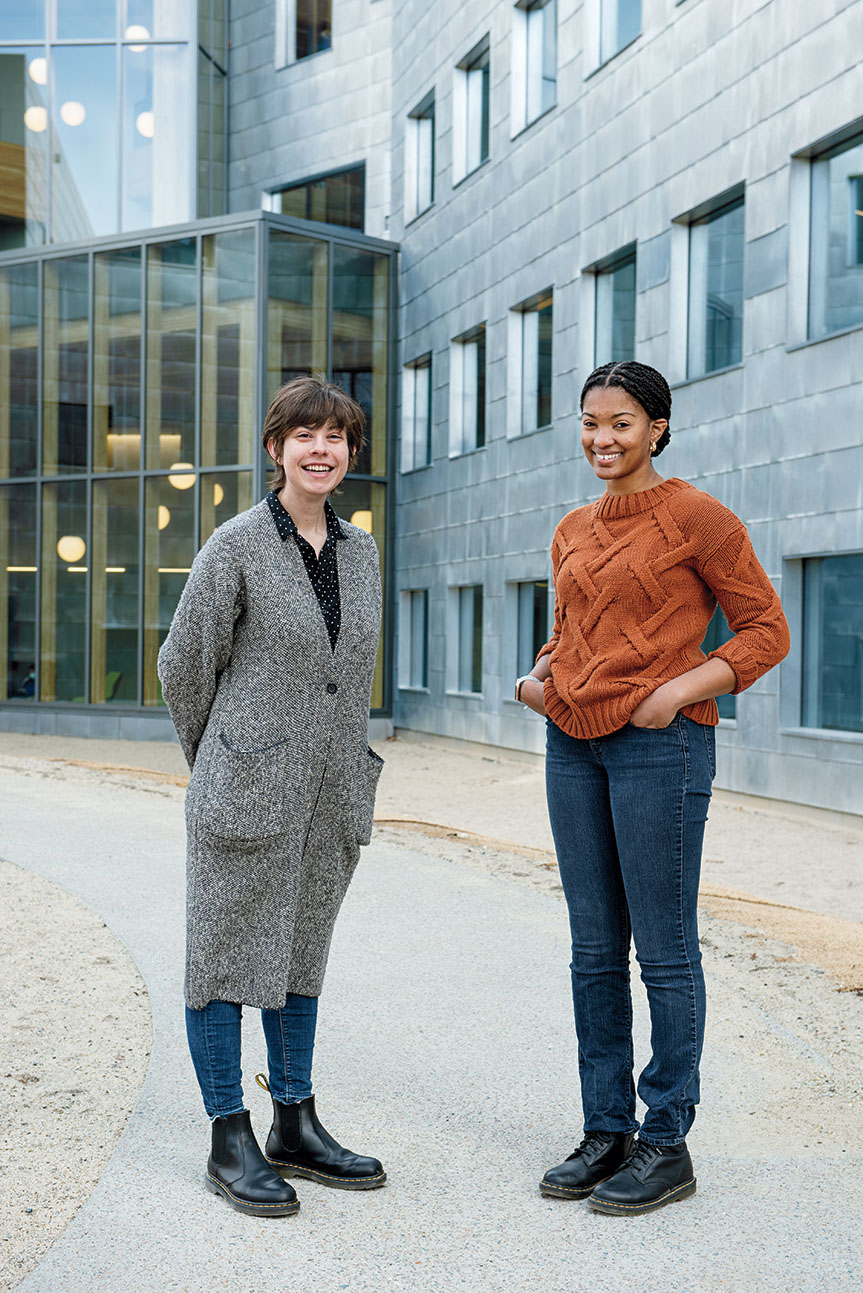
Science students Maddie Paoletti ’22 (left) and Noelle Davis ’25 are enjoying the new complex.
The Power of A Welcoming Space
From her perch in the Chao Foundation Innovation Hub, chemistry professor Stanley has been impressed by the power of physical space to enhance connectedness and community.
“The proximity of everything, and how it looks and how it feels, makes the whole science field more inviting, which is something we’re striving for at Wellesley—to make every student feel like science is for them. It’s not an issue of whether they’re majors or not, but that they can learn from science and that science is important. Having an inviting building helps that happen. It makes students want to be there.
“There’s just such energy when you have a beautiful space to work in, that everybody wants to be in,” she adds. “One student told me the second day that she felt like she never wanted to leave again. She had found her spot.”
Noelle Davis ’25 has found her spot, too. “I especially like the fourth floor, the penthouse has cubicles that are around the railings, and you can look down,” the first-year says. “I work in the Science Complex, but I’m also a student in the Science Complex. So I kind of get both sides of the new building. In the hub, I catch up with friends, I can go to the Leaky Beaker and buy a coffee or a muffin or something in the morning, and then sit and do some work,” she says. “But since I work as the instrumentation assistant, I’m able to go into the labs or work with the equipment and get some hands-on experience.”
On Tuesdays, Davis often ends up staying in the Science Complex from 9 a.m., when she arrives for her job, until 11:30 pm, when she leaves her favorite round orange cubicle in the penthouse to trek back across campus to Claflin. (She’s thinking about moving to Bates next year so she’ll be closer to Science Hill as she pursues her interest in STEM.)
“It’s really fascinating how they were able to capture old Wellesley with the Sage wall in the new building,” she says, “kind of like our past is going into our future.”
Catherine O’Neill Grace, senior associate editor, likes to hang out by the Michael and Denise Kellen ’68 Lounge and Sit Stair when she visits the Science Complex.





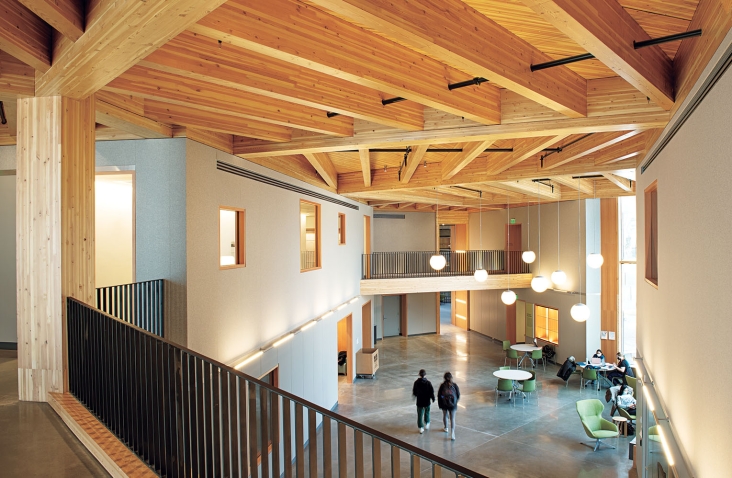
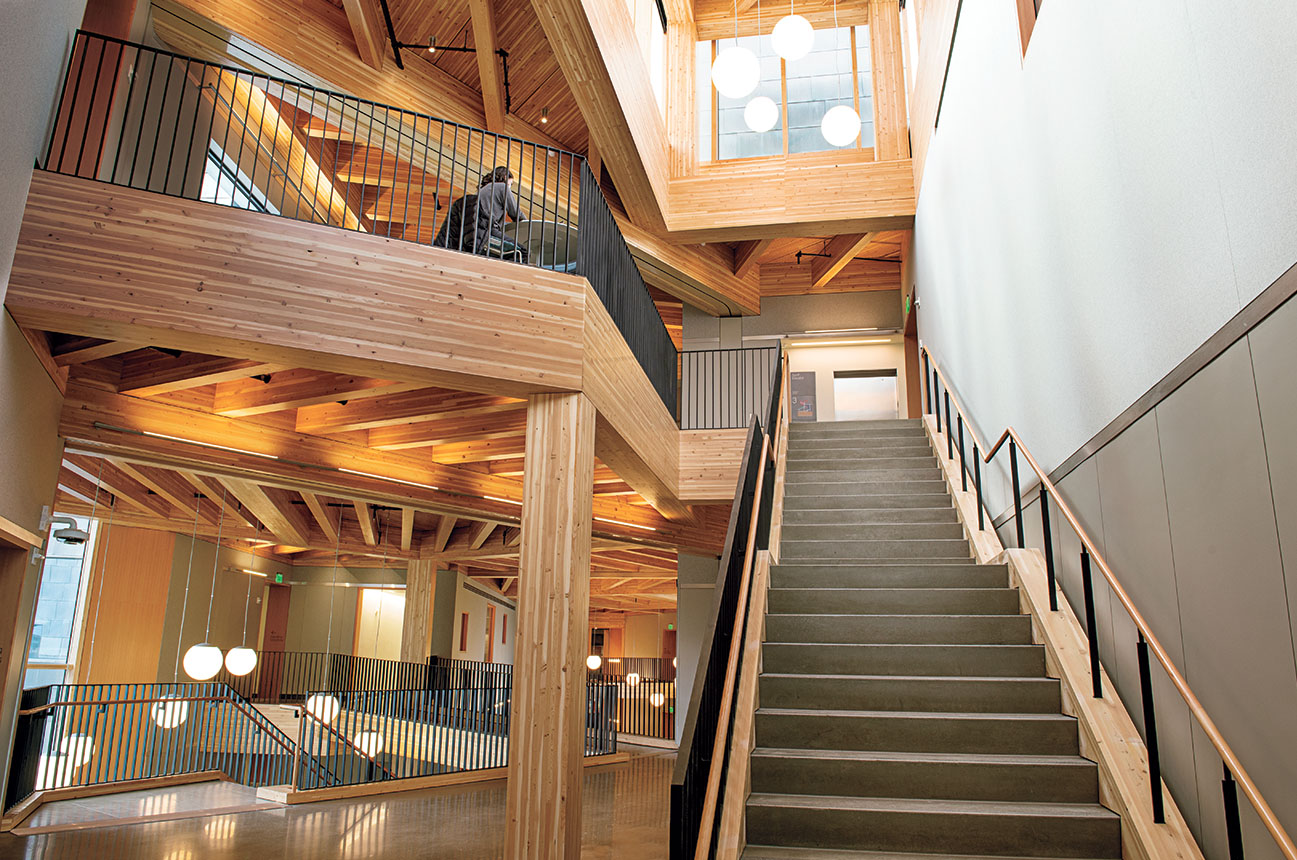
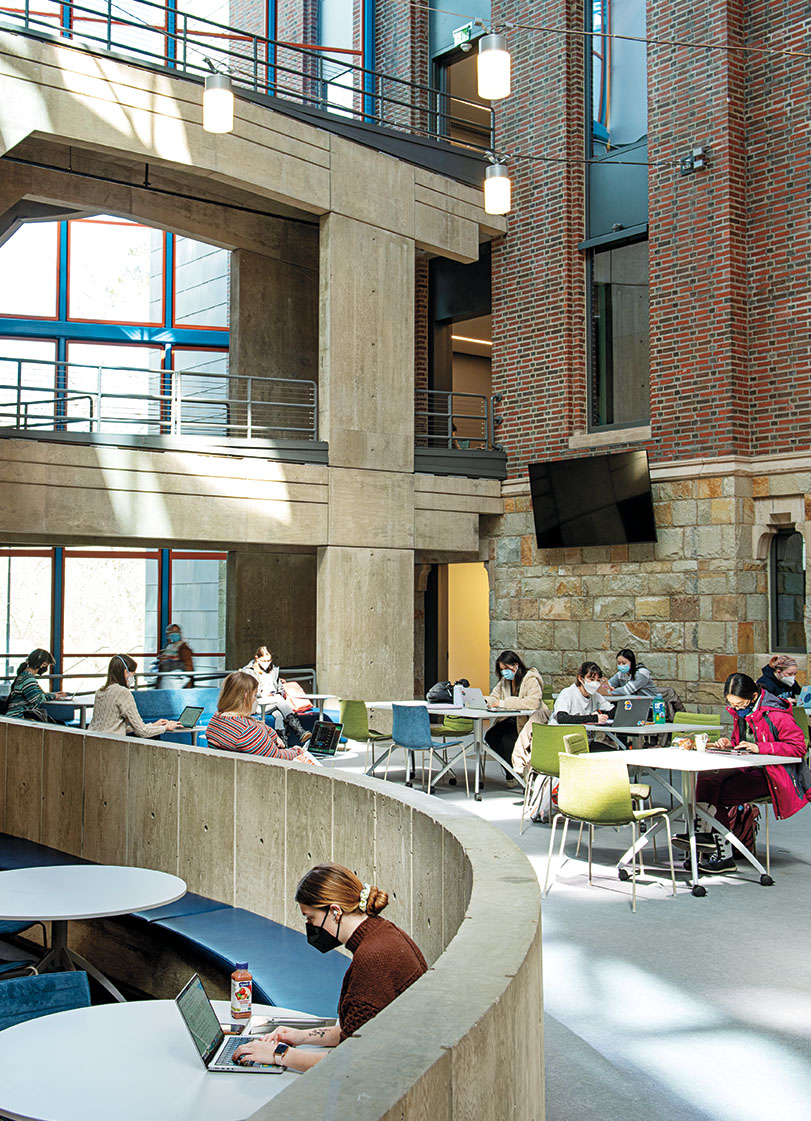
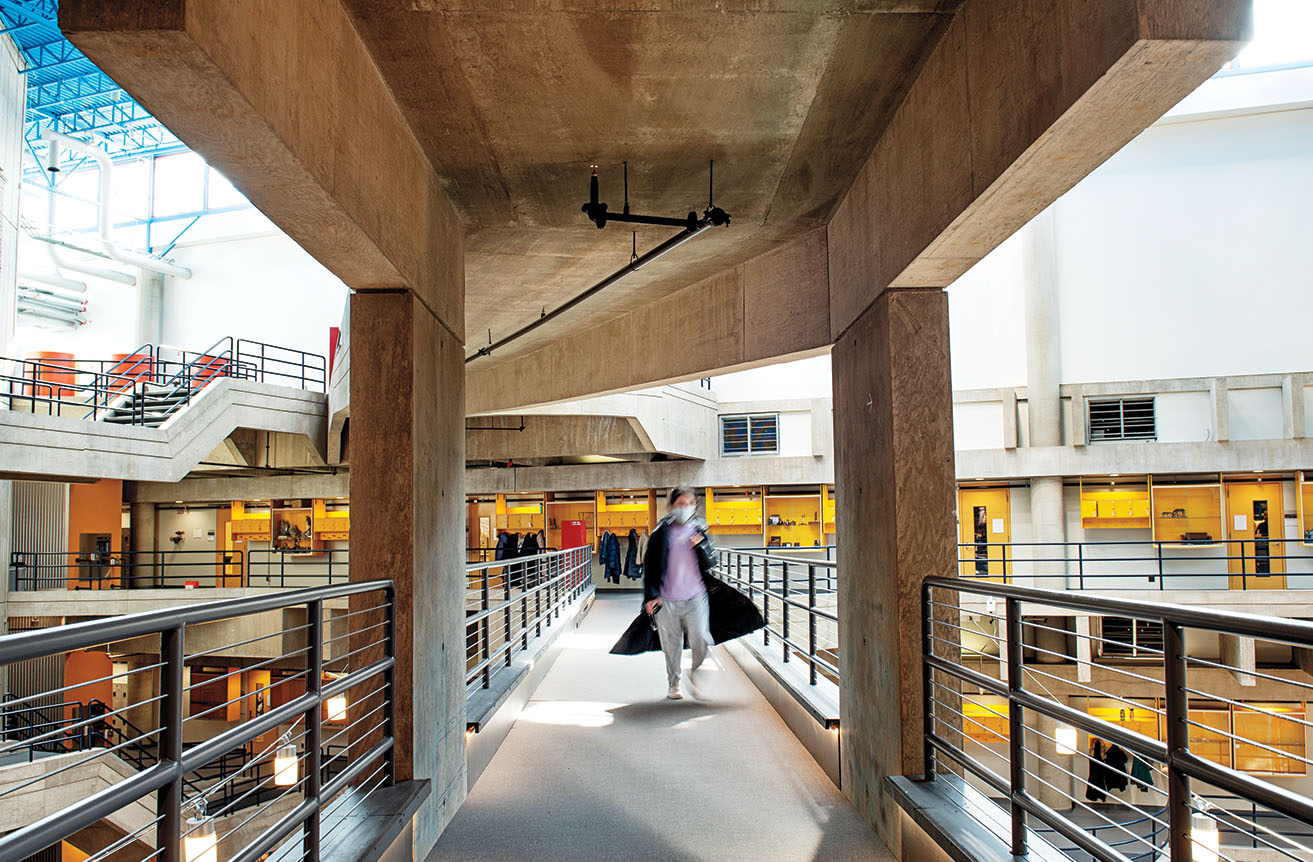
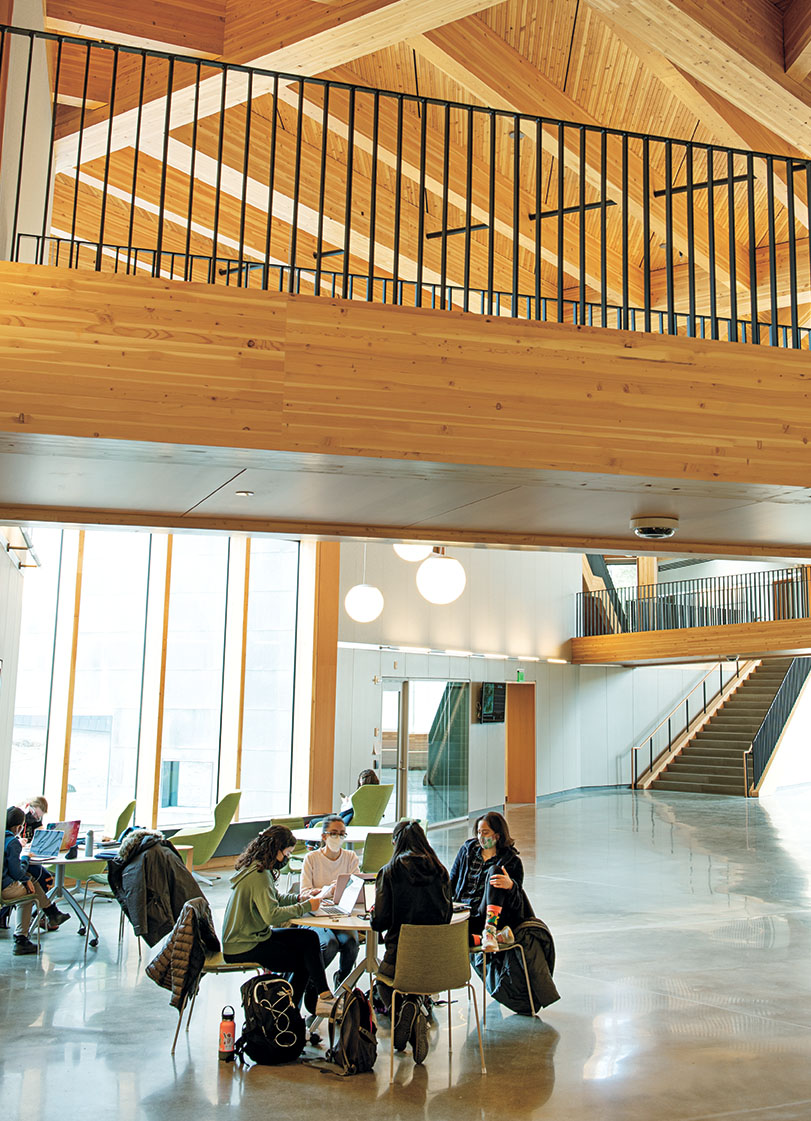
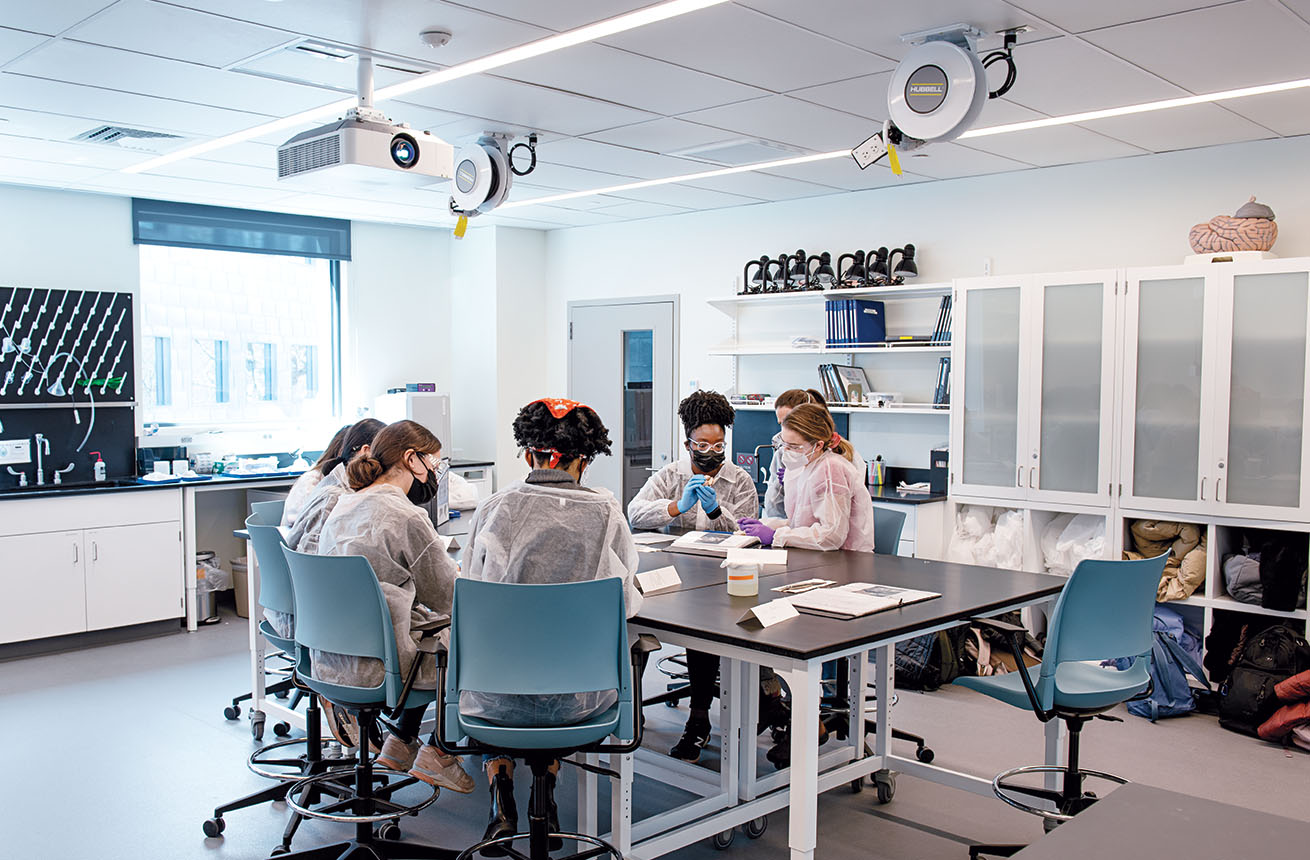
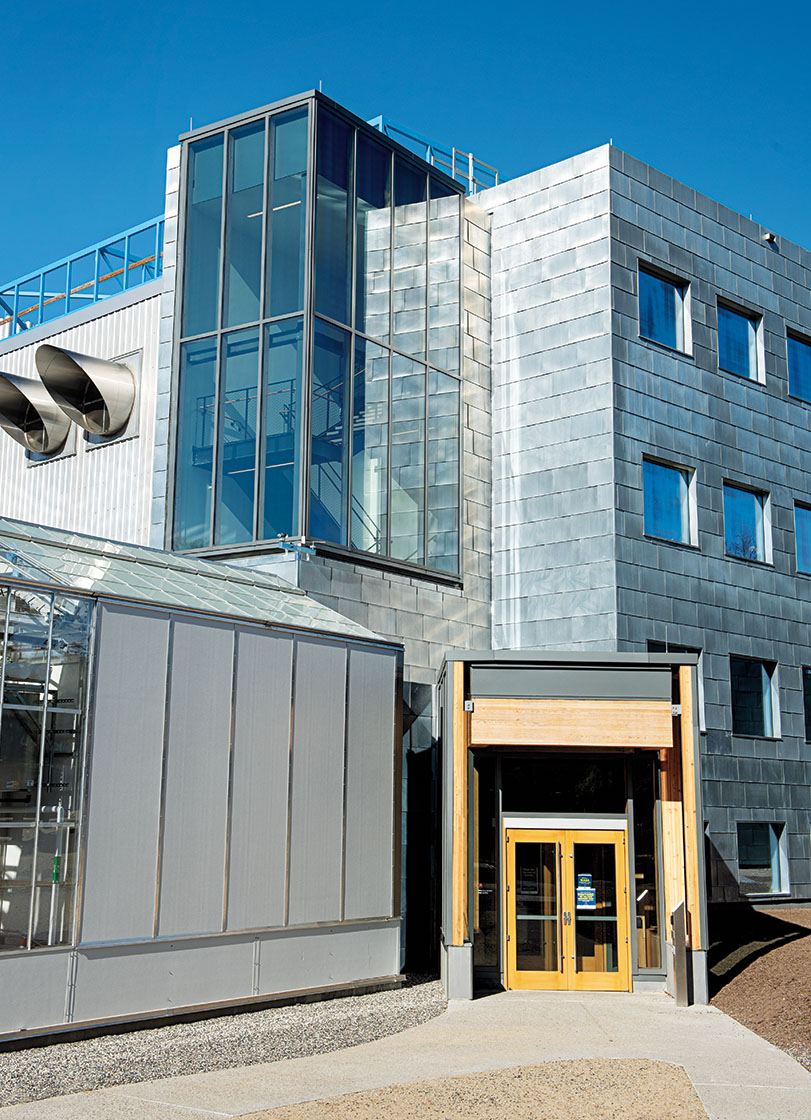
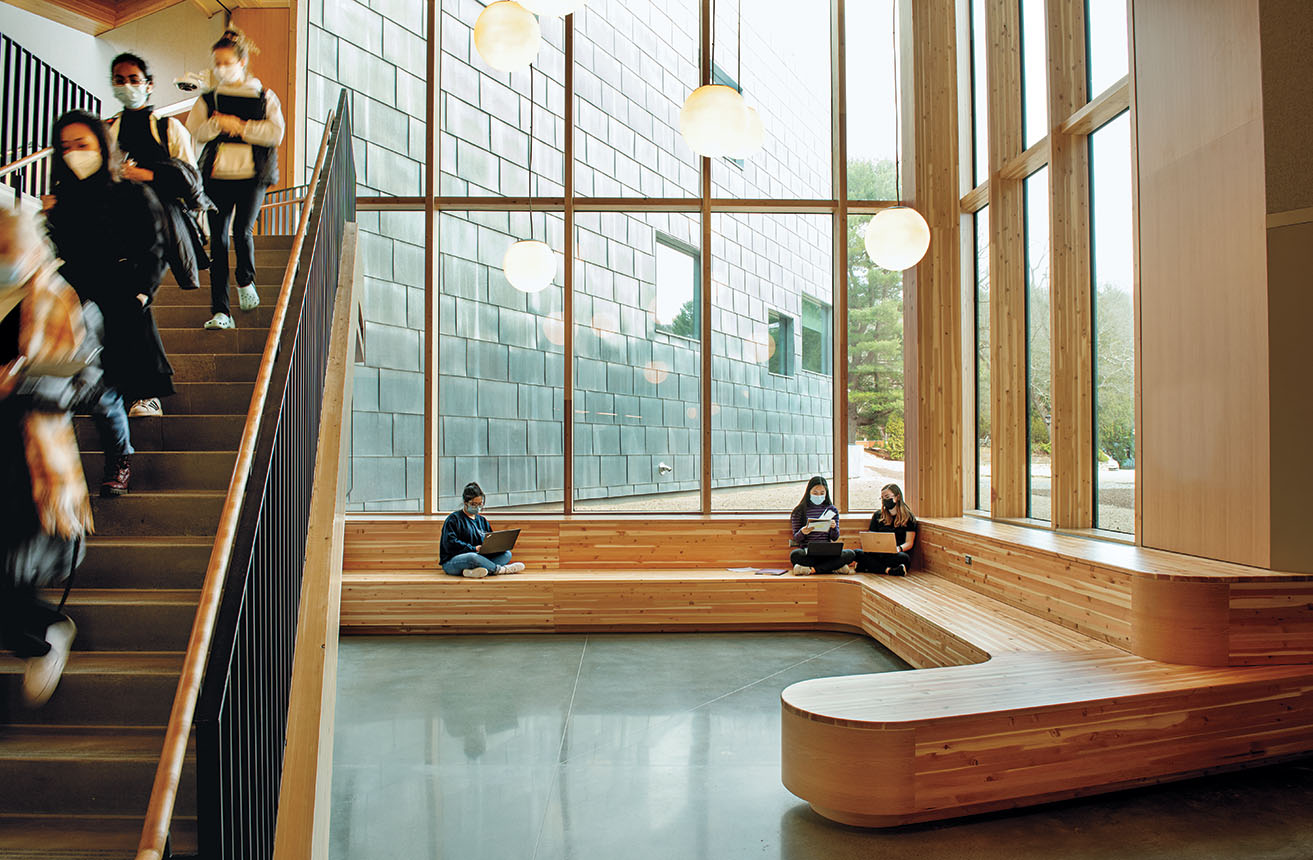


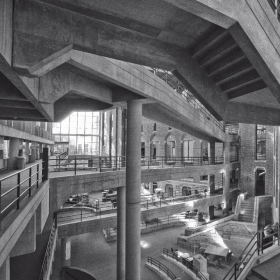

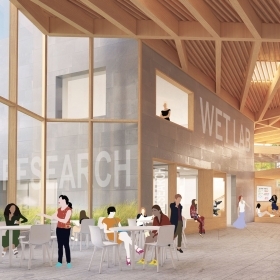
We ask that those who engage in Wellesley magazine's online community act with honesty, integrity, and respect. (Remember the honor code, alums?) We reserve the right to remove comments by impersonators or comments that are not civil and relevant to the subject at hand. By posting here, you are permitting Wellesley magazine to edit and republish your comment in all media. Please remember that all posts are public.